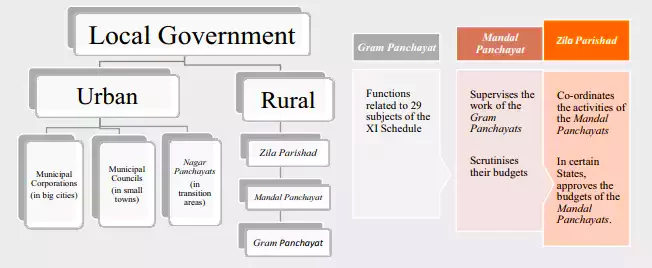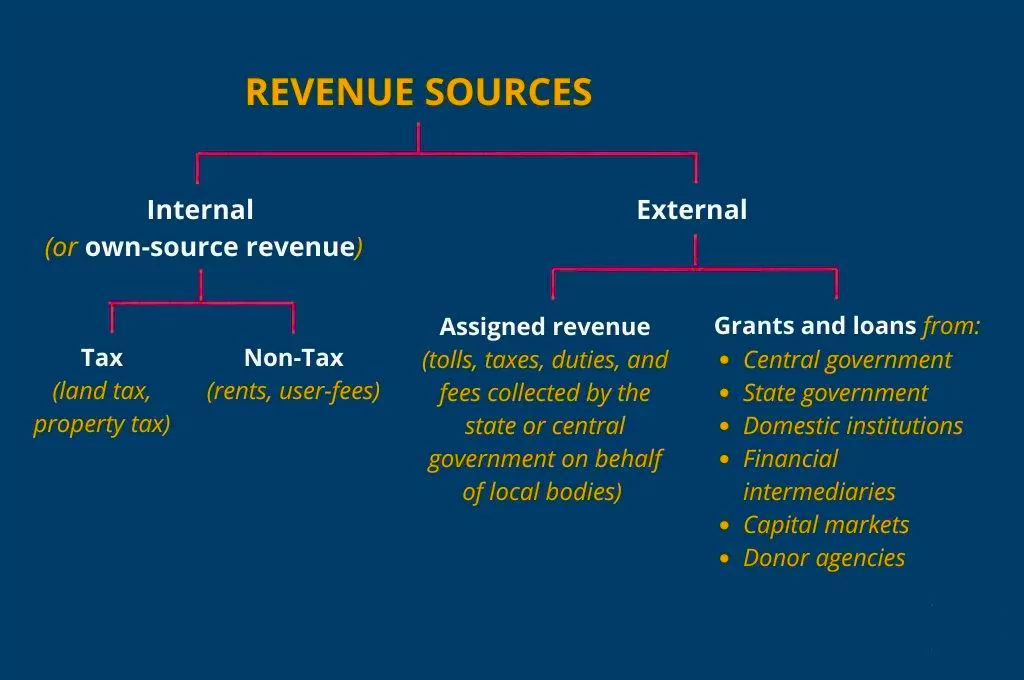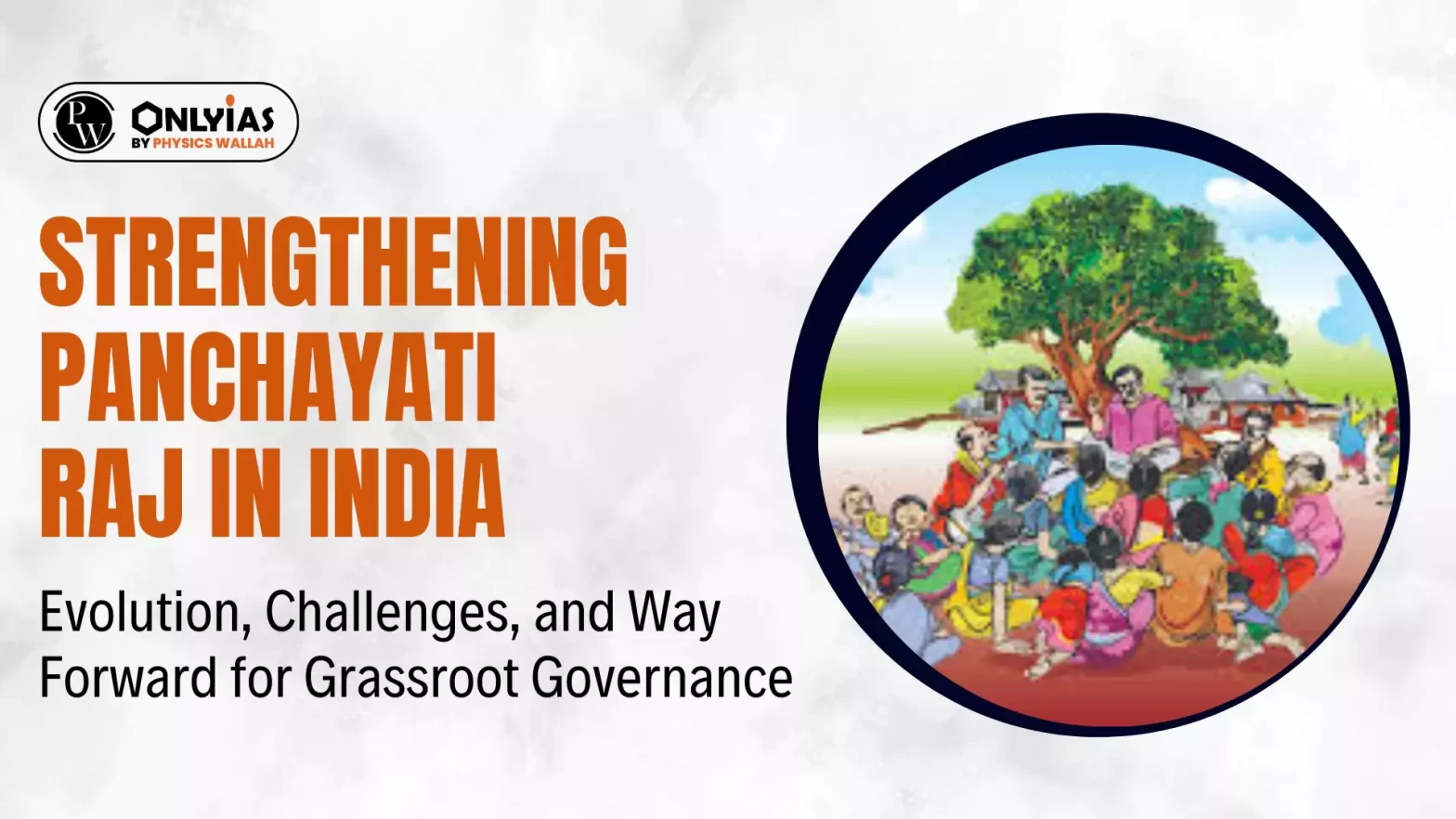Context
The Ministry of Panchayati Raj commemorates the 24th of April every year as National Panchayati Raj Day (NPRD) marking the enactment of the Constitution (73rd Amendment) Act, 1992, which came into force on 24th April, 1993.
National Colloquium on Grassroot Governance
- National Colloquium on Grassroot Governance: The Ministry of Panchayati Raj (MoPR) is organizing it after three Decades of the 73rd Constitutional Amendment” in observance of NPRD.
- Aims: To facilitate dialogue and collaboration among stakeholders, including officials from Central and State Governments, etc.
- Key Topics of Discussion: Discussions will focus on the evolution of principles of Good Governance in rural areas and pathways for strengthening PRIs as vehicles for effective public service delivery.
Enroll now for UPSC Online Course
About Grassroot Governance in India- Panchayati Raj and Municipalities
Grassroot Governance refers to the participation of local residents in village governance. The main objective behind it is that the people in the village should undertake the responsibilities of governing themselves.
- Participation from the local population, community, PRIs, SHGs, etc. helps in achieving the goals of sustainable development and environmental preservation.
- India has over 2.5 lakh gram panchayats, and over 2,000 municipalities and municipal corporations
- Services like supply of potable and clean water, sanitation, and management of solid waste are the few crucial services provided by the local governments.
Evolution of Grassroot Governance in India
-
Pre Independence:
- Municipal Corporation in Madras: The setting up of a Municipal Corporation in Madras in 1687 marked the beginning of local government in India.
- Charter Act of 1793: Under this, the local body in India acquired a statutory base and municipal administration was established in the presidency towns of Madras, Calcutta, and Bombay.
- Lord Mayo’s Resolution of 1870: It advocated decentralisation and made arrangements for strengthening the municipal institutions and involving more and more Indians in these bodies.
- Lord Ripon’s Resolution of 1882: It advocated the cause of decentralization of administration through the establishment of local selfgoverning institutions.
- The Resolution of 1882 has been described as the Magna Carta of local government.
- Royal Commission on Decentralisation 1907: It recommended that the village should be regarded as the basic unit of local self-government institutions, and every village should have a panchayat and municipalities should be constituted in urban areas.
- Government of India Act, 1919: It introduced ‘Dyarchy’ in the provinces, and local self-government became a transferred subject.
- The Act increased the taxation powers of the local bodies, lowered the franchise, reduced the nominated element, and extended the communal electorate to a large number of municipalities.
- Government of India Act, 1935: For the first time,, the Government of India Act, 1935 introduced a federal form of Government conferred ‘Provincial Autonomy’ on the provinces and envisaged selfgovernment for the country as a whole.
-
Post Independence:
- Balwant Rai Mehta Committee: To examine the working of the Community Development Programme (1952) and the National Extension Service (1953). It recommended:
- Establishment of an organically linked three-tier panchayati raj system through a device of indirect elections.
- Ashok Mehta committee 1977: It recommended a two-tier system – zilla parishad and mandal panchayat (consisting of a group of villages with a total population of 15,000 to 20,000)
- District as first point for decentralisation under popular supervision below the state level.
 73rd Constitutional Amendment Act, 1992: It constitutionalised the Panchayats and made mandatory for all the states to set up three-tier (in smaller states having less than 20 lakh population – two-tier) Panchayats:
73rd Constitutional Amendment Act, 1992: It constitutionalised the Panchayats and made mandatory for all the states to set up three-tier (in smaller states having less than 20 lakh population – two-tier) Panchayats:
- Zilla Parishad at the district level
- Panchayat Samiti at the block level
- Gram Panchayat at the village level
- 74th Constitutional Amendment Act: It constitutionalised the municipal local bodies by providing them with a constitutional status and also making it mandatory for the government to constitute them.
- A uniform three-tier structure of urban local bodies’ viz., Municipal Corporation, Municipal Councils and Nagar Panchayats was to be constituted.
Role of Panchayats in Grassroot Governance in India
- Constitutional Mandate: The Indian Constitution mandates panchayats to operate as self-governing institutions, urging state governments to rejuvenate local representative bodies.
- Implementing Development Policies at the Grassroots: Panchayati Raj Institutions (PRIs) are crucial in translating developmental policies into action at the grassroots level.
- They serve as intermediaries between the government and rural communities, fostering local participation and driving sustainable development initiatives.
- Catalysts of Local Development: Panchayats have several key responsibilities, including drafting economic development plans and schemes, advancing social justice through various initiatives, exercising tax, duties, tolls, and fees levying, collection, and appropriation.
- It also aided in decentralising governmental functions, notably financial responsibilities, to local levels.
- Monitoring Government Schemes: Panchayat members supervise various government programmes, such as the Integrated Rural Development Programme (IRDP) and the Integrated Child Development Scheme (ICDS).
Role of Panchayati Raj in India’s Socio-Economic Development
- Rural Development: PRIs prepare Village Development Plans (VDPs) and implement development projects by allocating resources based on local needs to align development initiatives with the priorities of the rural population.
- Panchayats also serve as implementing agencies for various Central and State government programmes and schemes to help in the targeted delivery of these programmes at the grassroots level.
- Agricultural Development: PRIs implement and oversee initiatives that boost agricultural productivity, support sustainable farming practices, and enhance the overall economic resilience of rural areas.
- For instance, cooperative endeavours like Amul have originated at the Panchayat level.
- SDG Localisation: The MoPR is advancing the Sustainable Development Goals (SDGs) in collaboration with PRIs across rural India.
- Providing Healthcare Facilities: Panchayats play a significant role in providing basic healthcare facilities through establishing and maintaining health centres, clinics, and dispensaries.
- Gram Panchayats contribute to improving maternal and child health by promoting institutional deliveries, encouraging prenatal and postnatal care, and reducing maternal and infant mortality rates.
- From 2021-22 to 2025-26, around 0.70 lakh crore was allocated for local governments for health, with 0.44 lakh crore specified for Rural Local Bodies (RLBs).
- Education: Panchayats collaborate with schools and parents to encourage enrolment, minimise drop-out rates, and actively monitor school operations, teacher attendance, and educational quality.
- Between 2018 and 2022, the enrolment of children aged 6-14 years in government schools in rural areas increased in all States, with Odisha, Gujarat and West Bengal recording more than 90 per cent of enrolment in government schools.
- Women Empowerment: There is a positive and significant correlation between increased women’s participation and improved outcomes in local governance.
- For instance, E. Duflo and R. Chattopadhyay, in a study involving the working of PRIs in West Bengal and Rajasthan observed that women’s representation has had a net positive impact on the delivery of local public goods to marginalised communities.
- Article 243D of the Constitution guarantees women’s involvement in PRIs by stipulating a minimum one-third reservation for women in both the total seats filled by direct election and the positions of Panchayat Chairpersons.
Enroll now for UPSC Online Classes
How Are Local Bodies Funded?

- Internal (or own-source revenue): They raise themselves, either through taxes such as land or property tax, or through non-tax sources which include rents and user-fees.
- External Revenue Sources: It includes:
- Assigned revenue, which covers taxes, duties, tolls, and fees due to local bodies, that are collected by the state and central governments.
- The exact percentage allocation of these revenues is done through recommendations of State Finance Commissions.
- Grants-in-aid and loans from the central and state governments, domestic institutions, financial intermediaries, capital markets, and/or donor agencies.
|
Challenges Faced by Grassroot Governance in India
- Functions: The power to devolve functions to local governments rests with the state government. However, the states have not devolve adequate functions to local government bodies, severely affecting the system’s efficiency and effectiveness.
- Creation of Parastatal Bodies: State governments created parallel structures for the implementation of projects around agriculture, health, and education—undermining areas for which local bodies are constitutionally responsible.
- Non-functionality of District Planning Committees (DPC): The 74th amendment requires a DPC to be set up in each district, so that the development plans prepared by the panchayats and urban local bodies can be consolidated and integrated.
- However, DPC are non-functional in nine states, and failed to prepare integrated plans in 15 states.
- Finances: Most local bodies, both rural and urban are unable to generate adequate funds from their internal sources, and are therefore extremely dependent on external sources for funding.
- Around 80 percent to 95 percent of revenue is obtained from external sources, particularly state and central government loans and grants.
- Reasons for low internal revenue collection:
- Local bodies lack the capacity to properly impose taxes, due to ambiguous taxation norms, lack of reliable records, and so on.
- State governments have not devolved enough taxation powers. Most states only permit local bodies to collect property taxes and water tariffs, but not land tax or tolls, which can provide more substantial revenues.
- Functionaries: According to the Standing Committee on Rural Development, there is a severe lack of support staff and personnel in panchayats.This affects their functioning and delivery of services by them.
- Poor Infrastructure: Around 25 percent of the Gram Panchayats do not have basic office buildings. The database for planning, monitoring etc., are lacking in most of the cases.
- Structural deficiencies: No secretarial support and lower levels of technical knowledge which restricted the aggregation of bottom up planning.
- Presence of Panch-Pati and Proxy representation in case of women and SC/STs representatives respectively. (At 1.4 million, India has the most women in elected positions).
- Impact of Seat Rotation on Female Political Careers: Women representatives have identified the policy of rotation of reserved seats every five years as a barrier to the continuation of their political careers.
- With the rotation of seats, female candidates are not able to gain from their experience from one term to the next, and they end up returning to their roles at home after a single term in office.
- Concern pertaining to SFC (State Finance Commission):
- Delay in Constituting SFC: Out of 26 states, only nine states have constituted 6th State Finance Commissions, and out of them, only two are active. Some states have not even constituted 4th and 5th Finance Commissions.
- This leads to the local self-governments being deprived of their legitimate share from the Consolidated Fund of the State.
- Non-Availability of Data: The non-availability of data related to local government hampers the workings of SFCs.
- Every time an SFC is constituted, it has to start from scratch to collect data.
- Lack of expertise of SFC: The majority of the members and chairpersons of the SFCs are bureaucrats and politicians.
- This puts limitations on the ability of the SFC to act as an autonomous body to make recommendations in a free and independent manner.
Government Initiatives to Strengthen Panchayati Raj Institutions (PRIs)
- e-Gram Swaraj e-Financial Management System: It is a Simplified Work Based Accounting Application for PRI that assists in enhancing the credibility of Panchayat through inducing greater devolution of funds to PRIs.
- Rashtriya Gram Swaraj Abhiyan (RGSA) Scheme: It integrates various interventions within the MoPR and across sectors, employing participatory local planning at the Gram Panchayat level.
- Saansad Adarsh Gram Yojana: It envisions the holistic development of villages, transforming them into Adarsh Grams.
- Panchayat Development Index (PDI): To measure the progress on LSDGs and to carry out assessment to prepare evidence-based policy, MoPR constituted a Committee to prepare mechanisms for computation of PDI.
- Gram Urja Swaraj Abhiyaan: MoPR has collaborated with the Ministry of New and Renewable Energy to include the Gram Panchayats under all its schemes focusing on adoption of renewable energy.
- International Centre for Audit of Local Governance (iCAL): CAG has established it as a centre of excellence for capacity building of local government auditors at the national and the international levels.
Best Practices in Panchayati Ra Institution Implementation
- Andhra Pradesh: It established a village secretariat to effectuate better service delivery and broadening participatory democracy.
- Karnataka: It created a separate bureaucratic cadre for Panchayats to get away from the practice of deputation of officials who often overpowered the elected representatives.
- Minimum Qualification Standards for Panchayat Elections: States like Rajasthan and Haryana have set certain minimum qualification standards for Panchayat elections which can help in improving the effectiveness of governance mechanisms.
|
Way Forward to Grassroot Governance in India
- Devolving 3Fs: State governments should make adequate efforts to devolve funds, functions, and functionaries to panchayats for them to effectively plan economic development and social justice schemes.
- The Standing Committee on Rural Development recommended that states devolve subjects like fuel and fodder, non-conventional energy sources, small scale industries including food processing industries, technical training, etc. to panchayats.
- Timely Establishment of State FC: Prompt establishment of SFCs, avoiding the sizable delays that occur currently, assumes importance.
- SFCs can strengthen the financial position of PRIs and help them in better delivery of their responsibilities for upliftment of the rural economy.
- Following Principle of Subsidiarity: It means that higher levels of government should perform only those functions that cannot be effectively performed at the local level.
- Thus, the basic services must be provided to the citizens by the PRIs.
- Local Revenue Generation: PRIs can improve local revenue generation and use their limited resources more efficiently and effectively through measures such as transparent budgeting and fiscal discipline, active involvement of the local community etc.
- According to National Institute of Rural Development and Panchayati Raj (NIRDPR) , the Velpur Gram Panchayat (GP) in the Nizamabad district in Telangana has demonstrated effective revenue generation from internal sources.
- Social Empowerment Must Precede Political Empowerment: Clear mechanisms to ensure that States comply with the constitutional provisions, particularly in the appointment and implementation of the recommendations of the SFCs.
- Capacity Building for Self-Governance: This includes training to local representatives– to develop expertise so that they contribute more in planning and implementation of policies and programmes.
- Improving Participation: The Standing Committee on Rural Development recommended that state governments should put a quorum in gram sabha meetings for participation of panchayat representatives, including women.
- Technology in Local Governance: Information and Communication Technology (ICT) comprising digital tools and technologies, revolutionizes governance by enhancing communication, transparency, service delivery, and citizen engagement.
- Through the internet and mobile technology, PRIs can communicate efficiently, disseminate vital information, and engage citizens even in remote areas.
- Digital platforms aid in transparent data sharing, planning, and analysis, while data analytics systems facilitate evidence-based decision-making.
- Sampoorna Swaraj Foundation has developed a navigated learning system curates specialised learning activities for each learner to facilitate their journey to the required level of knowledge and skill.
Enroll now for UPSC Online Course
Conclusion
India’s local governance system needs to be empowered in all three areas to ensure that power truly rests with the people, not just on paper, but also in practice.
Also Read: RBI Report On Finance Of Panchayati Raj In India
![]() 23 Apr 2024
23 Apr 2024

 73rd Constitutional Amendment Act, 1992: It constitutionalised the Panchayats and made mandatory for all the states to set up three-tier (in smaller states having less than 20 lakh population – two-tier) Panchayats:
73rd Constitutional Amendment Act, 1992: It constitutionalised the Panchayats and made mandatory for all the states to set up three-tier (in smaller states having less than 20 lakh population – two-tier) Panchayats: